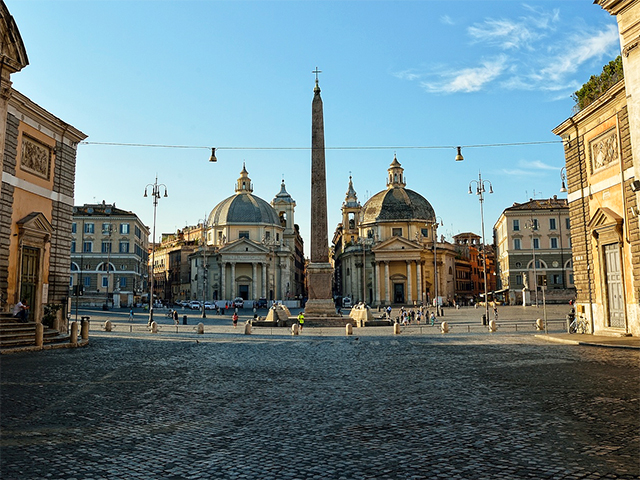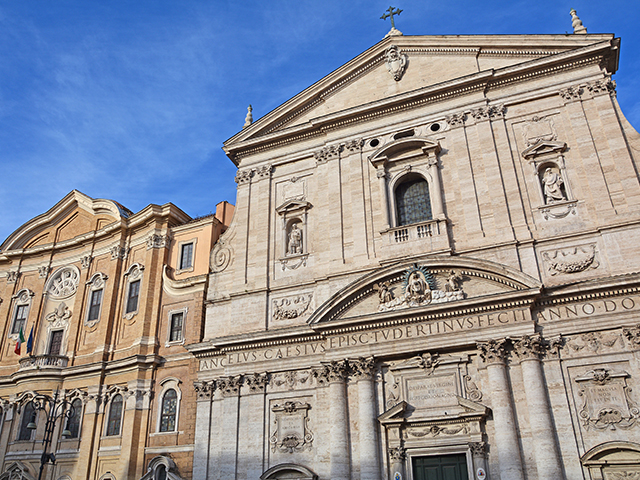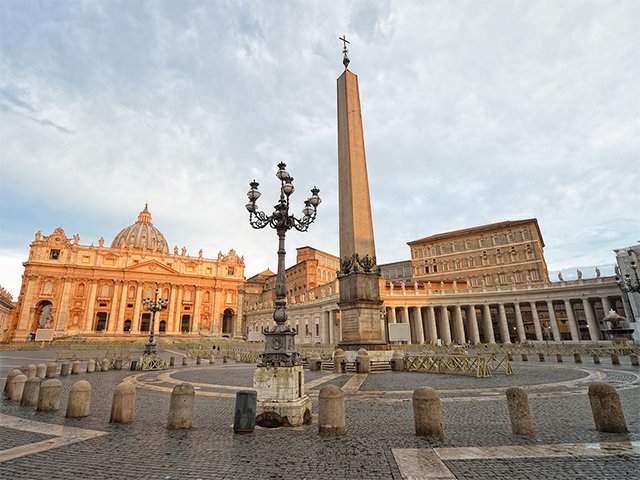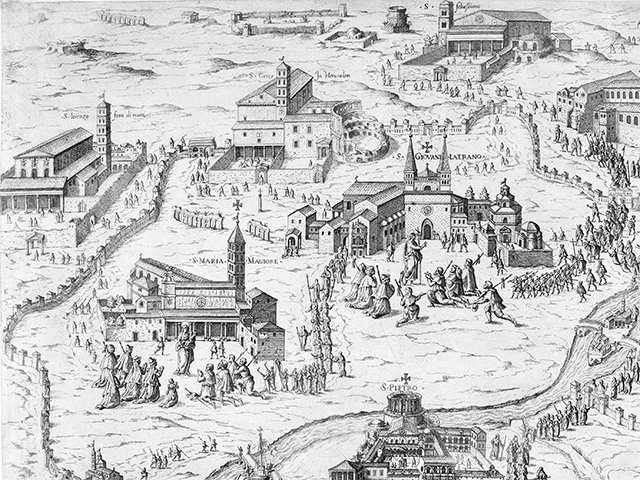Piazza Navona
Fom the Fountain of the four Rivers to the traditional Befana market: Piazza Navona is this and much morePiazza Navona, born from the ashes of the ancient stadium of Domitian, is among the most beautiful and important squares of Rome.
Great meeting place, the square is always heaving with street artists, painters, tourists but also the Romans themselves. Despite the wide impact of tourism, many come here to sit on benches, to eat a gelato or merely to have a chat in the bars and pubs that make the square come to life. Piazza Navona can, in fact, be considered the most loved square by Romans.
During Christmas time, until the traditional night of the Befana (an old woman who delivers gifts to children on the night of January 5th), the square is illuminated with thousands of colours, and it is filled up with stalls selling sweets, artisan objects and Nativity figurines.
ESCAPE GAME ROME FROM PIAZZA NAVONA
WALKING TOUR ON THE SECRETS OF ROME
THE HISTORY OF PIAZZA NAVONA
Piazza Navona, with its fountains, its buildings and the wonderful Church of Sant'Agnese in Agone represents the true la vera quintessence of the Roman Baroque.
Its characteristic elliptical shape retraces the old perimeter of the stadium below, built by emperor Domitian in 86 d.C. for the Greek Athletic Games, the so-called agones, from which comes the name of the square. A fake metropolitan legend has it that the concave square was used as a theatre for naval battles, while actually truth is that the square was flooded in summer with the water coming from the fountains to fight the intense heat.

Piazza Navona
The stadium of Domitian was well 275 meters long and 106 wide, and it could host up to 30,000 spectators! The remains of this old structure are 6 meters below the current street level and can still be seen in a building located in Piazza di Tor Sanguigna and in the underground rooms of the church of Sant'Agnese in Agone.
The square hosted in the past also the local market, with stands arranged following the oval shape. Over time, the market was moved to the neighboring Campo dei Fiori, where it is located to this day. Only during Christmas time, and especially during Epiphany, the stalls come back to the square for the traditional Befana market of Piazza Navona.
THE CHURCH OF SANT'AGNESE IN AGONE
They say that during Christian persecution by Diocletian (between 303 and 313 AD) a young girl called Agnese, after refusing the love of the son of the Prefect of Rome, was exhibited naked as punishment, in the place where at that time prostitutes gathered. Legend goes that the girl, who had taken the vow of chastity, saw her hair grow miraculously completely covering her body. In that place was built the church in her honor.
The oldest structure dates back to the 8th century, but it has been rebuilt several times, until it was replaced in 1652 by the majestic church that can still be admired nowadays. Pope Innocent X commited the works to Girolamo and Carlo Rainaldi, and lately Borromini stood in for them, working on the church from 1653 to 1657, keeping to the initial project, except for the façade, confering a particular vertical thrust.
The interior is very bright, filled with gold and decorative marbles, and it stands out by the vertical dimension given to the structures holding the dome.
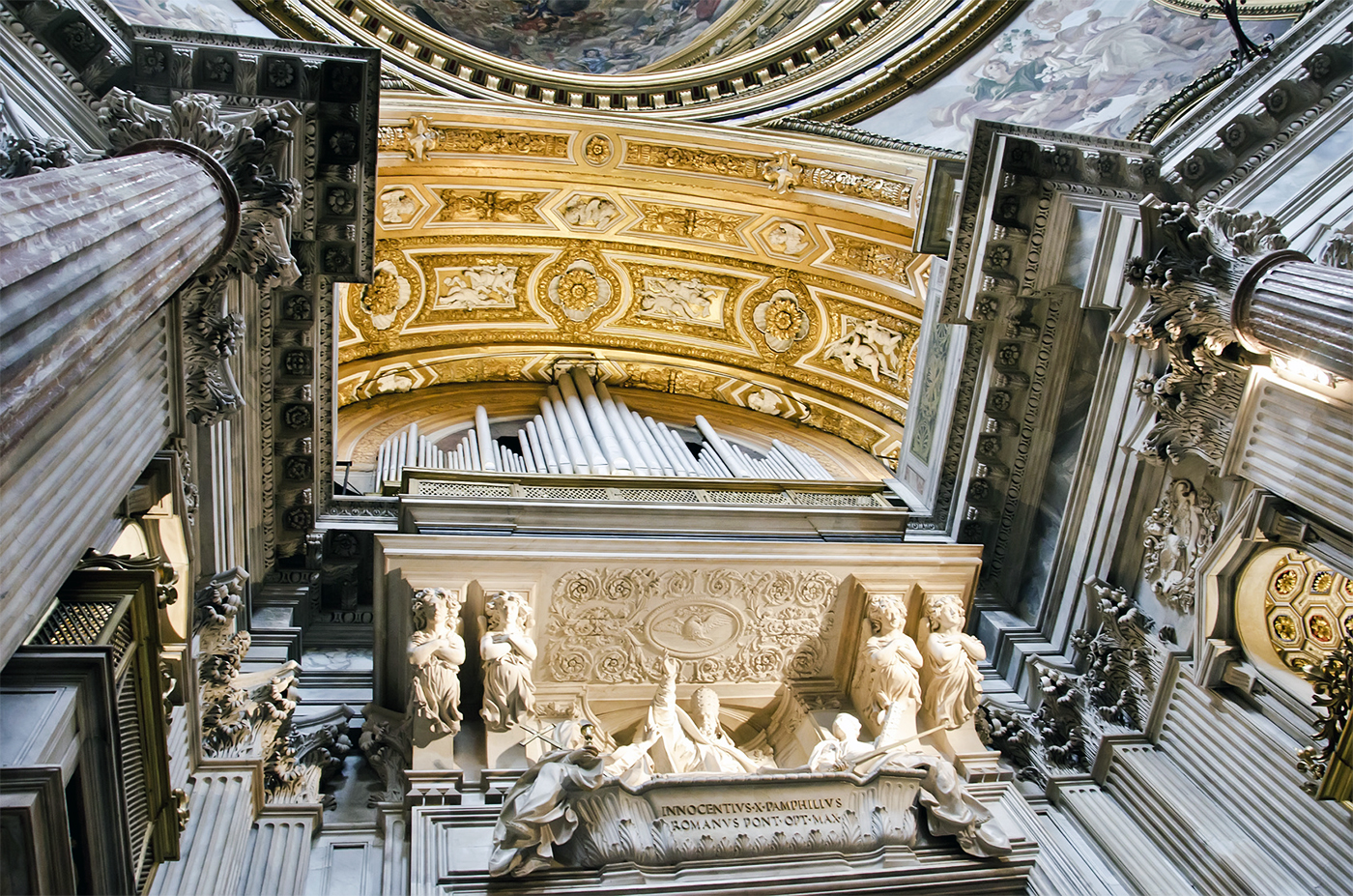
Church of Sant'Agnese in Agone
THE FOUNTAINS OF PIAZZA NAVONA
In the middle of the square is placed the Fountain of the Four Rivers made in 1651 by Gian Lorenzo Bernini. The fountain is a great architectural and sculptorical baroque work, formed by a reef made of stone representing the earth, with grottoes hollowed out of it, from where a lion and other fantastic animals go out to quench their thirst. Everything is holding the Egiptian obelisk saved from the Circus of Maxentius.
The four colossal statues symbolise the four big rivers from the four continents: the Nile, the Ganges, the Danube and the Río de la Plata. The fountain is, finally, crowned by the dove of the Holy Spirit and it can be thus interpreted as a symbol of the triumph of the Church over the whole world.
A curiosity: tradition says that Bernini, bitter enemy of peer Borromini, willingly made the statue of the Río de la Plata with his arm up, like protecting himself from the imminent fall of the bell tower while the statue of the Nile has his face covered as if not wanting to look at the Church!
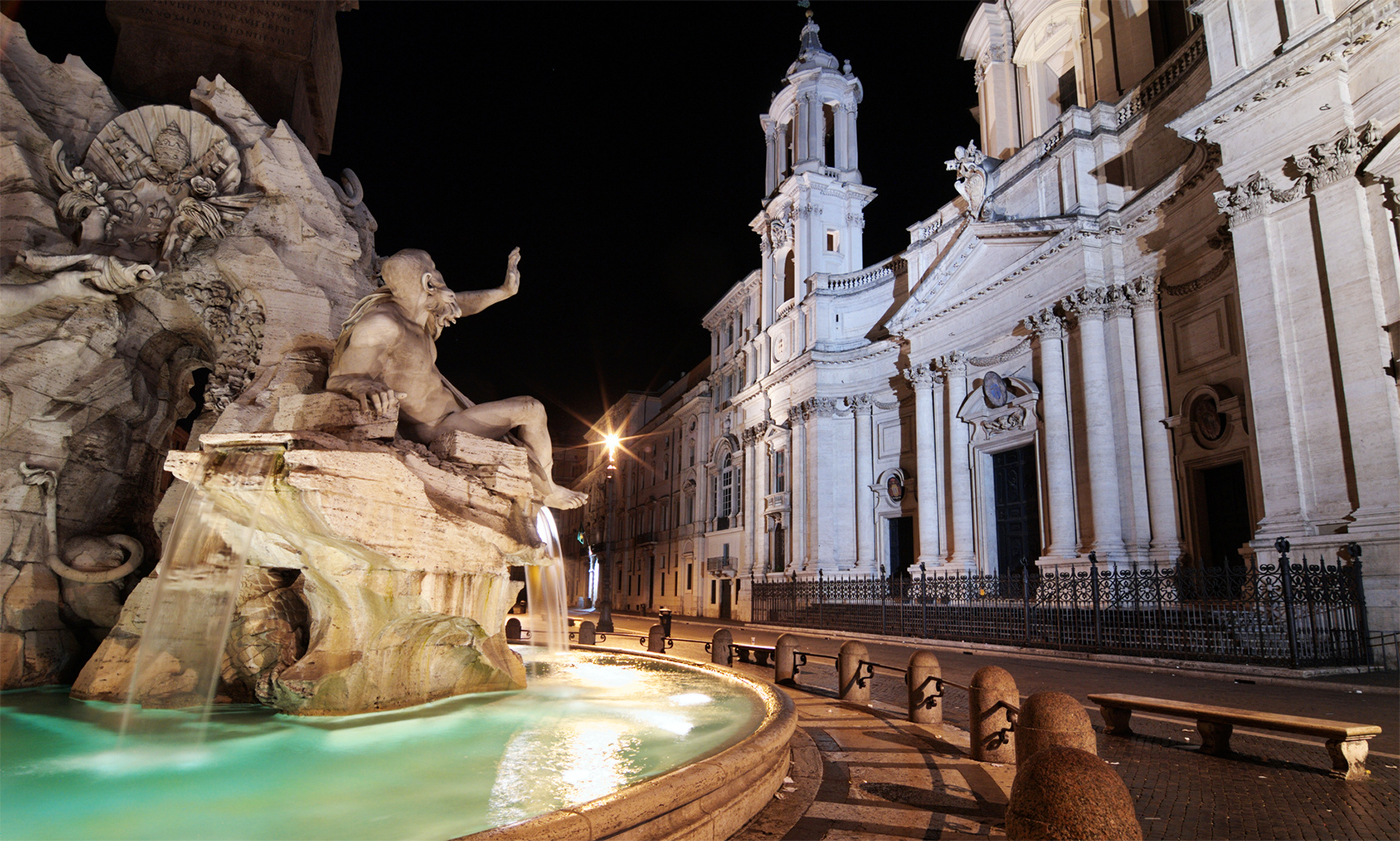
Fountain of the Four Rivers - Particular of the statue of Rio de la Plata protecting himself from the collapse of the bell tower!
Borromini disciples, in turn, replied upholding that the fountain was empty in its core, and that it would not be able to bear the weight of the obelisk. Then, Bernini, who didn't lack sense of humour, had his assistants tie overnight four thin ropes to the obelisk, in a gesture of mockery.
Beyond the playful dispute between the two of them, we can luckily today note that they were both right and wrong and they works have stayed unchanged and stable in all their splendour to present day.
PALAZZO PAMPHILJ AND OTHER FOUNTAINS
Within the square is located the majestic Palazzo Pamphilj, built by Girolamo Rainaldi by will of Pope Innocent X, looking out onto the Fountain of the Moor and on the opposite extreme, to the Fountain of Neptune.
The Fountain of the Moor was built by Giacomo della Porta and embellished by Bernini himself, who sculpted the central figure, that gives the name to the fountain.
Also the Fountain of Neptune, located in the North side of the square, is a work by Della Porta. Initially, it was called "Fountain of the Braziers" because it was placed in the alley with the same name. It took its current name after the addition of two sculptural groups: "The Nereidi with cupids and sea horses" by Gregorio Zappalà and "Neptune fights against an octopus" by Antonio della Bitta, built after a public contest organised by Rome City Council in 1873.

Piazza Navona - Palazzo Pamphilj, Church of Sant'Agnese in Agone and the Moor Fountain
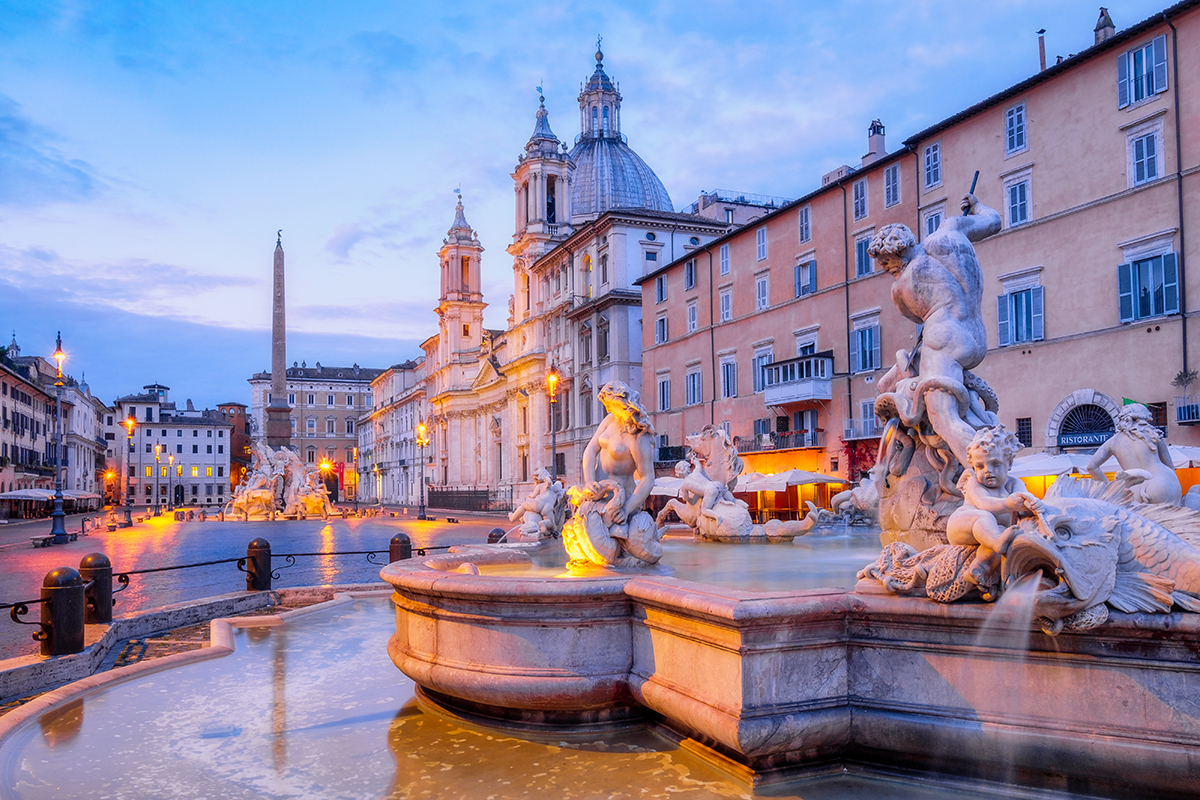
Fountain of Neptune
PIAZZA NAVONA TODAY
Visiting the center of Rome, you can't avoid croosing this square! If the saying is true and all roads lead to Rome, then it's also true that all streets in Rome lead to Piazza Navona! There are, in fact, many entries to the Piazzaand it is not coincidence, given the importance that the square has had over the history of the city.
Piazza Navona is today a meeting place for many street artists, living statues, clowns, musicians and singers, all of them making the square on of the most alive and interesting places of the city. There is no shortage of stalls of painters and portrait painters who in few minutes will make your visit even more fun, handing a perfect caricature as souvenir to you!
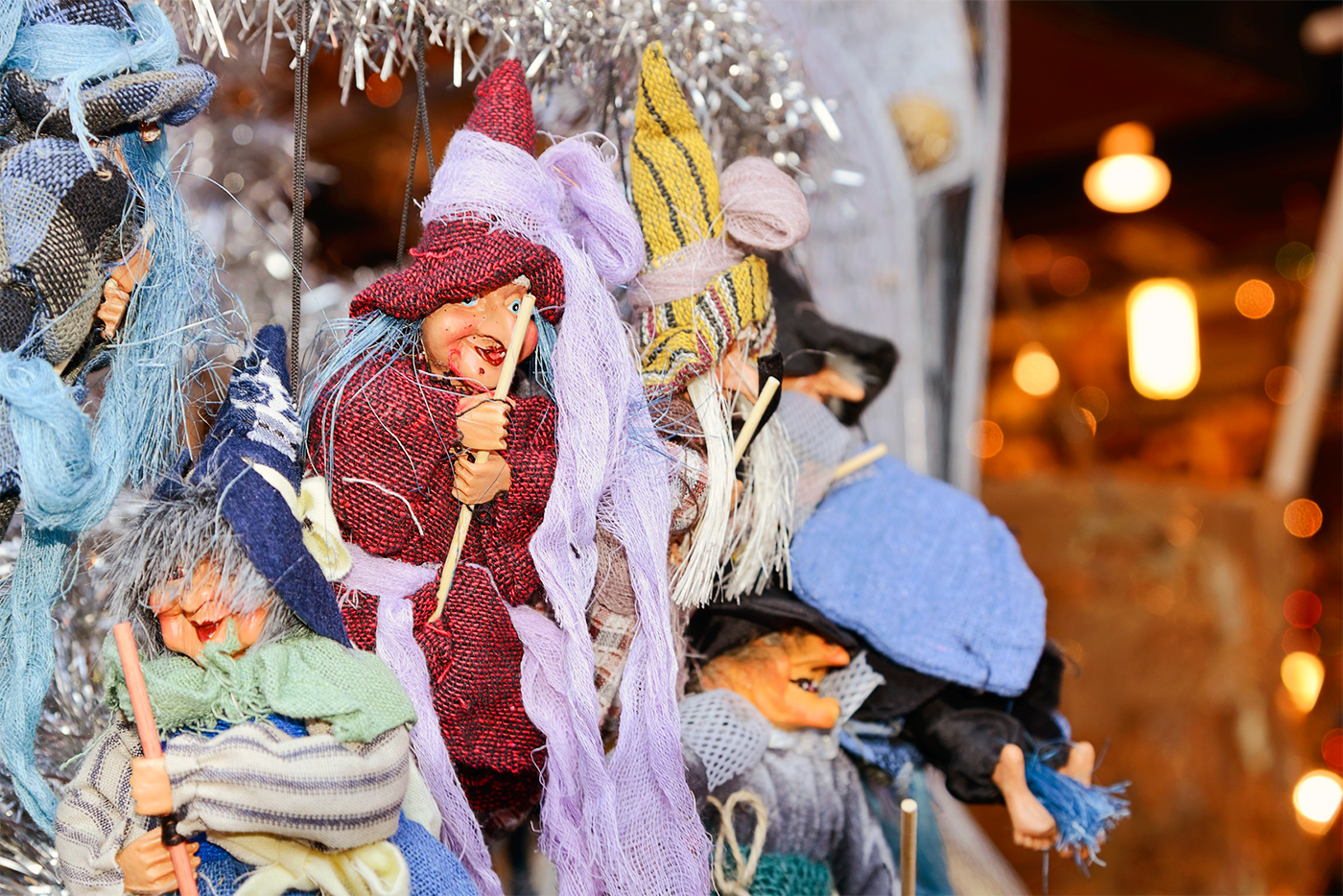
Traditional markets on the occasion of the Befana in Piazza Navona
An unmissable appointment in Piazza Navona is the traditional Christmas market! If you happen to be in Rome during Christimas time, you can't absolutely miss going to the square decorated with carousels, coloured lights, stalls of sweets, toys and much more.
The celebration culminates right the day of the Epiphany with the arrival of the Befana, who brings sugar and coal to all children!
Did you like our article? Tell us your travel experience and help us improve it. You can leave your comment inthe box at the bottom of the page!
Useful information
Piazza Navona
- HOW TO GET THERE
Plan your trip from the port of Civitavecchia following our directions:
From the Port of Civitavecchia: to get to Piazza Navona first go to Civitavecchia station and get on the first train bound for Rome. After about one hour trip, get off at Roma Termini Station and go towards Piazza dei Cinquecento, the bus terminal.
We recommend to get line 64 - P.ZA STAZIONE S. PIETRO (FL) for 9 stops. Get off at C.SO VITTORIO EMANUELE/S. A. DELLA VALLE in Corso Vittorio Emanuele II. Turn right in Via della Cuccagna and after just 350 metri by walk you will be there.
From Rome: Piazza Navona is not connected to the subway but it is nonetheless connected to many bus lines: 46, 571, 492, 62, 628, 64 (for who is coming from Termini Station), 70, 81, 87, 916 and C3. Regarding night bus lines, you can count with number n15, n20, n5, n6 and n7. We invite you to check the night bus timetables, since they don't run very often.
*For train timetables and routes refer to Trenitalia.*For further information about bus timetables and routes, depending on where you are, you can refer to ATAC.- TIMETABLES
- Chiesa di Sant'Agnese in AgoneWeekdays: 9.30 - 12.30 and 15.30 - 19.00Holidays: 9.00 - 13.00 e 16.00 - 20.00Closed on MondaysLandline phone: +39 0668192134
- PRICES
Free admission.



 PORT MOBILITY CIVITAVECCHIA
PORT MOBILITY CIVITAVECCHIA








